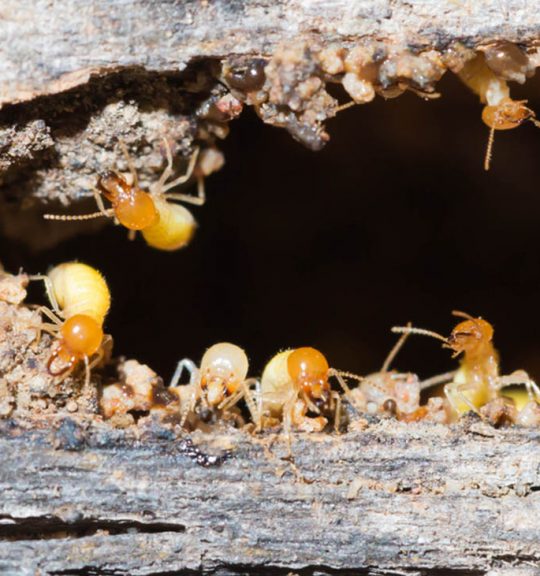Surekil Pest Control are a family owned and run business that have been providing effective, affordable pest control services to Gold Coast and Tweed Heads families since 1998.
Residential pest control traditionally involves a general approach, where appropriate pesticides are applied throughout the property to provide effective control of a wide range of pests for a period of approximately 12-months.
If you are looking to reduce the amount of chemicals and pesticides used around your property but still want effective pest control, Surekil are introducing our new subscription Pest Defender plans with our Targeted Pest Control approach option. Under our Targeted Pest Control approach, only specific nuisance pests are targeted using integrated pest management techniques and the minimal amount of chemicals and pesticides.
If you do prefer the more traditional approach, our Pest Defender plans include both annual and bi-annual pest control service options.
We provide pest control services in Coomera, Southport, Ashmore, Currumbin, Nerang, Broadbeach Waters, Burleigh Heads, Bilinga, Arundel, Molendinar, Bundall, Ocean Shores, Cabarita and Pottsville. Get in touch for more information.

Annual Inclusions
Pests Treated
| Ants Caterpillars Cockroaches Crickets Earwigs Fleas Lice Millipedes | Moths Stored Product Pests Rodents Silverfish Slaters Spiders Ticks Wasps |
Annual Inclusions
Pests Included
| Ants Caterpillars Cockroaches Crickets Earwigs Fleas Lice Millipedes | Moths Stored product pests Rodents Silverfish Slaters Spiders Ticks Wasps |

Annual Inclusions
Pests Treated
| Cockroaches Ants Spiders Silverfish Wasps Rodents Fleas Ticks | Slaters Millipedes Moths Stored product pests Crickets Earwigs Lice Caterpillars |
Annual Inclusions
Pests Included
| Cockroaches Ants Spiders Silverfish Wasps Rodents Fleas Ticks | Slaters Millipedes Moths/Stored product pests Crickets Earwigs Lice Caterpillars |

Annual Inclusions
Pests Treated
| Ants Caterpillars Cockroaches Crickets Earwigs Fleas Lice Millipedes | Moths Stored Product Pests Rodents Silverfish Slaters Spiders Ticks Wasps |
Annual Inclusions
Pests Included
| Ants Caterpillars Cockroaches Crickets Earwigs Fleas Lice Millipedes | Moths Stored Product Pests Rodents Silverfish Slaters Spiders Ticks Wasps |

Annual Inclusions
Pests Treated
| Cockroaches Ants | Spiders Silverfish |
Annual Inclusions
Pests Included
| Cockroaches Ants | Spiders Silverfish |

Annual Inclusions
Pests Treated
| Ants Cockroaches | Silverfish Spiders |
Annual Inclusions
Pests Included
| Ants Cockroaches | Silverfish Spiders |

Annual Inclusions
Pests Treated
| Cockroaches Ants Spiders Silverfish Wasps Rodents Fleas Ticks | Slaters Millipedes Moths/Stored product pests Crickets Earwigs Lice Caterpillars |
Annual Inclusions
Pests Included
| Cockroaches Ants Spiders Silverfish Wasps Rodents Fleas Ticks | Slaters Millipedes Moths/Stored product pests Crickets Earwigs Lice Caterpillars |

Annual Inclusions
Pests Treated
| Ants Caterpillars Cockroaches Crickets Earwigs Fleas Lice Millipedes | Moths Stored Product Pests Rodents Silverfish Slaters Spiders Ticks Wasps |
Annual Inclusions
Pests Included
| Ants Caterpillars Cockroaches Crickets Earwigs Fleas Lice Millipedes | Moths Stored product pests Rodents Silverfish Slaters Spiders Ticks Wasps |

Annual Inclusions
Pests Treated
| Cockroaches Ants Spiders Silverfish Wasps Rodents Fleas Ticks | Slaters Millipedes Moths Stored product pests Crickets Earwigs Lice Caterpillars |
Annual Inclusions
Pests Included
| Cockroaches Ants Spiders Silverfish Wasps Rodents Fleas Ticks | Slaters Millipedes Moths/Stored product pests Crickets Earwigs Lice Caterpillars |

Annual Inclusions
Pests Treated
| Ants Caterpillars Cockroaches Crickets Earwigs Fleas Lice Millipedes | Moths Stored Product Pests Rodents Silverfish Slaters Spiders Ticks Wasps |
Annual Inclusions
Pests Included
| Ants Caterpillars Cockroaches Crickets Earwigs Fleas Lice Millipedes | Moths Stored Product Pests Rodents Silverfish Slaters Spiders Ticks Wasps |

Annual Inclusions
Pests Treated
| Cockroaches Ants | Spiders Silverfish |
Annual Inclusions
Pests Included
| Cockroaches Ants | Spiders Silverfish |

Annual Inclusions
Pests Treated
| Ants Cockroaches | Silverfish Spiders |
Annual Inclusions
Pests Included
| Ants Cockroaches | Silverfish Spiders |

Annual Inclusions
Pests Treated
| Cockroaches Ants Spiders Silverfish Wasps Rodents Fleas Ticks | Slaters Millipedes Moths/Stored product pests Crickets Earwigs Lice Caterpillars |
Annual Inclusions
Pests Included
| Cockroaches Ants Spiders Silverfish Wasps Rodents Fleas Ticks | Slaters Millipedes Moths/Stored product pests Crickets Earwigs Lice Caterpillars |
The prices indicated are for residential properties of up to 40m2, typically a 3 or 4-bedroom home. For prices for properties of other sizes or commercial services, please contact us on 07 5599 1322 or request a quote.
**Our goods and services come with guarantees that cannot be excluded under the Australian Consumer Law.
With more families looking to reduce the amount of chemicals and pesticides used around their properties, Surekil are introducing our new subscription Pest Defender plans with our new Targeted Pest Control approach option. Under our Targeted Pest Control approach, only specific nuisance pests are targeted using integrated pest management techniques and the minimal amount of chemicals and pesticides.
Of course, if you prefer to have your service carried out annually, you can still choose the general option.


If you are vacating a rental property, then you probably need end of lease pest control also known as a move out spray or bond treatment and if you have pets, then you’ll probably need to include a flea treatment as well, to ensure that you satisfy the requirements to claim your bond back!
Prices start from just $120.00*, contact our friendly team on 07 5599 1322 to find out more.
Working alongside Strata and Body Corporate Managers across the Gold Coast and Northern NSW, Surekil Pest Control’s expert team provide fast, reliable and professional Termite Management and Pest Control solutions for some of the smallest to the largest and best-known Schemes around.
For more information or to arrange a quote, please contact our friendly office team on 07 5599 1322.

Below are some of the industry leading products that we use for pest control:
Pest Control Prices*
Standard Services
*Warranty Terms and Conditions
All warranty periods listed, represent the maximum available periods and serve as a guide only, the actual periods offered are at the discretion of the technician at the time of the service and are based on conducive conditions and environmental factors.
Our goods and services come with guarantees that cannot be excluded under the Australian Consumer Law. For major failures with the service, you are entitled:
You are also entitled to choose a refund or replacement for major failures with goods. If a failure with the goods or a service does not amount to a major failure, you are entitled to have the failure rectified in a reasonable time. If this is not done you are entitled to a refund for the goods and to cancel the contract for the service and obtain a refund of any unused portion. You are also entitled to be compensated for any other reasonably foreseeable loss or damage from a failure in the goods or service.
Testimonials

Request a Quick Quote or contact Us

Request a Quick Quote or contact Us

1300 991 322
07 5599 1322
After Hours: 0405 141 114
Monday – Friday: 7:30 – 16:00 AEST
Saturday: Appointment Only
Sunday: Closed

Monday – Friday: 7:30 – 16:00 AEST
Saturday: Appointment Only
Sunday: Closed